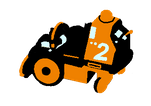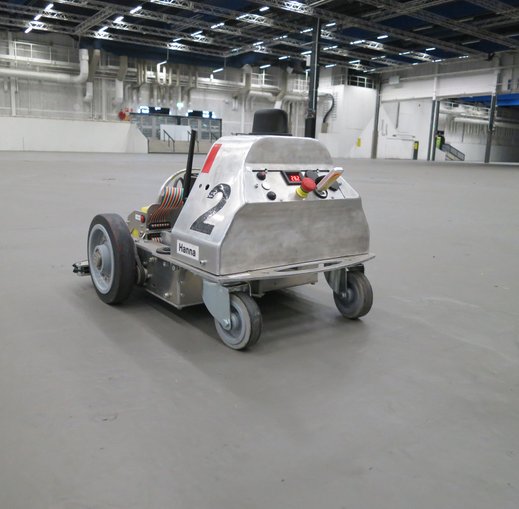The benefits with the system
- The most substantial impact is the reduction of labour cost. ROI may easily be calculated for anyone who keeps track on these costs today. Example: What earlier required 20+ man-hours of manual work, marking up an event in a 22000 sqm hall, now takes 5 man-hours for one single operator.
- Improved space utilization, due to shortened lead times between events, should be possible to measure for anyone who already keeps track on relevant reference data.
- Cost reduction due to reduced errors as a result of the “human factor”.
- The effect of eliminations of repetitive strain injuries RSI of the labour may be harder to calculate but the gains from a working environment perspective should be quite obvious.
- The system is very robust and reliable. It is well proven in real operations by Stockholmsmässan over many years.
Production capacity
The capacity measured by sqm/hour depends on how many marks you want to do per stand and the size of the stands. However, the experience from Stockholmsmässan is that one robot have the capacity to mark 20 000 sqm during 8 hours. The largest area that has been market up to today is 24 000 sqm for one robot at one and the same occasion. From a technical point of view there is no upper limit concerning the size of area to mark more than the battery capacity, see further down. If time is important you can run two or more robots in parallel at the same area.
General description of the system
The marking of the stand position is done directly on the floor with a digital printer mounted in an autonomously controlled robot. The layout of the markers is based on the ordinary CAD-files from the planning of the event layout.
The chassis of the robot is made of aluminium and the design is very robust. The robot is battery powered and two drive wheels, one on each side, controls the motion. For support, additional two swivel casters are mounted in the rear end of the robot. In the front the robot is equipped with a bumper for mechanical obstacle detection.
A laser scanner with 360° scanning field is used for positioning and obstacle detection. The laser is connected to an onboard computer. The computer has software for positioning and navigation based on SLAM (Simultaneous Localization and Mapping) technique and software for motion control, obstacle detection and obstacle avoidance.
For the marking the robot carries an inkjet character device, printing markers (symbols, measurements and text) on most hard and flat surfaces. The robot can mark event layouts with any number of booths, with any orientation and with an array of irregular shapes, with a standard accuracy of 30 mm.
The robot is operated by a graphic user interface on a laptop. The laptop is communicating remotely with the robot through a pear-to-pear wifi-network. All the robot functions are available via this user interface. On the robot itself a very rudimentary interface is installed with functions like on/off, battery voltage, operation mode indication and emergency stop. The robot also has a number of USB interfaces for connecting USB-memory sticks. The data-files for hall maps and marking instructions are loaded into the robot by the USB memory stick.
Battery
The standard battery is a 25 volt lithium-Ion battery with 29 Ah capacity. The battery running operation time (marking a normal event layout) is well over 8 hours. However, if extra capacity is requested, the robot can be equipped with two batteries and the total battery capacity adds up to 58 Ah. The cycle lifetime of the battery is 400-500 full discharge/charge cycles.
Charging time is approximately 12 hours with the standard charger. If shorter charging time is requested, a more powerful charger can be used and reduce the charging time to a few hours.
Obstacle avoidance
The robot has capability to detect and manoeuvre around temporary and unknown obstacles (obstacles that is not included in the map files), for example people moving in front of the robot. The robot has two independent detection mechanisms, the laser scanner and the mechanical bumper in the front.
Positioning and navigation
The robot uses an eye-safe laser scanner for positioning and orientation. The laser is reading walls and pillars as “landmarks”. Therefore, it is important that the halls have walls and pillars that can reflect the laser beam in an efficient way. As the laser beam has a practical range of about 30 meters, the layout of the hall should be such that the robot positioned anywhere in the hall gets efficient readings from landmarks. If the layout of the hall is very open (roof construction without pillars) it can be necessary to temporary add artificial landmarks during the marking process. One and a half meter vertical plastic tubes with a diameter of 75 -100 mm works very well as temporary landmarks.
Colours
The printer and colour container is placed in a separate cassette that easily can be exchanged from the robot, takes a few seconds. At normal operation you have different cassettes with different colours. When changing colour you just change the cassette. Today we have 4 standard colours, white, yellow, black and red. For an extra cost we can compound new colours at your request.
The marks can be washed away using detergents with a specific PH value, making it possible to control if markers should be kept or not while conducting normal floor cleaning. By using different colours multiple event layouts can be marked at the same marking occasion.
CAD-files and marks
The system needs two packages of information. First a drawing of the hall itself as a CAD-file. That drawing has to be very correct concerning the measurements, within a centimetre or so. The CAD-file is processed in a PC with a software program supplied by us. The program generates an XML data file with map data for the specific hall. This has only to be done once per hall if not any changes is made of the shape of the hall. The second CAD-file is the drawing over the actual event layout to be marked. Also that CAD-file is processed in a PC with our software and another XML data file with information like coordinates and stand numbers as well as instructions like starting point, directions and block marking order is generated. The XML files are then loaded into the on-board computer via an USB-memory stick. In this process you can determine in what order the stands will be market and how many marks per stand. If the stands are numbered in the CAD-file, that number will then be printed in the marks associated to that stand. Today we can handle CAD-files in the format .dwg, but we will extend the capability to other formats as well.
Maintenance
The robot does not require any specific maintenance. Of course the battery has to be charged after operation. Also the printer head has to be cleaned with cleaning fluid after every operation to avoid paint to dray and jam the printer nozzles. The cassettes are prepared with an extra container for cleaning fluid. Just by switch a valve on the cassette the printer head easily can be cleaned.
After a long time use the printer head needs to be send for service. Also all mechanical parts need to be checked for wear and function.
Contact makers
For more information concerning technical information, price or arrangements of demonstration, please contact:
Per Ljunggren
Intelligent Machines Stockholm AB
Mail: per.ljunggren@intmach.com
Phone: +46 (0)8 257098
Contact users
For more information concerning user experiences please contact:
Erik Förell
Stockholmsmässan AB
Mail: erik.forell@stockholmsmassan.se
Phone: +46 (0)8 749 42 51
Fair marking robot
Many in the industry are aware of the challenges with utilizing the space as efficiently as possible. Tight event calendars require lean operations when it comes to planning, producing, moving in, running the show, moving out and tearing down, keeping the lead times as short as possible.
The marking of the stand positions, before actual production starts, is often performed during night or at other odd hours and typically under stress. Traditionally the marking is carried out manually with tape and a long tape measurer. It is a very tedious and boring job, also very time- and labour consuming and therefore a costly operation.
Our robot based system, transforms these challenges into an effective, sustainable and cost saving operation using modern technology.

